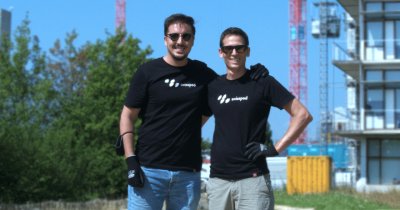The company will use the investment for research and development, early production validation, and commercial rollout.
The total round Swisspod is targeting is €1.1 million. The company already attracted as investors Seldor Capital — a Venture Capital firm that finances start-ups in the space technologies industry, and Robert Karsunky — Head of Pharma at Novartis Latin America & Canada.
Swisspod was created in 2019 by two SpaceX Hyperloop Pod Competition winners — Denis Tudor (CEO, a 28-year-old Romanian) and Cyril Dénéréaz (CTO). Following a conversation with Elon Musk, co-founder and CEO of SpaceX, the two young engineers decided they wanted to build the most efficient, affordable, and sustainable high-speed transportation solution.
Using Hyperloop technology, Swisspod develops a novel intracontinental freight transportation solution called SWIPT, consisting of a dynamically adjusted pressure environment, dedicated infrastructure through which electric vehicles transport palletized goods. As an electric and energy autonomous transport solution, it addresses the issues of carbon emissions, energy consumption, traffic, and capacity while aiming to transform the fragmented logistics architecture into an open, standardized, and automated network.
"Our system architecture reduces rail system costs by an order of magnitude and makes the project economically feasible. In the long term, we are focused on implementing our commercialization strategy and entering new markets. We are currently focusing on developing SWIPT, our hyperloop platform for freight transportation, and demonstrating the product's viability for market deployment. The following steps will include identifying a pilot route for our Hyperloop solution, catalyzing private and political interest in building it, and establishing partnerships with early adopters in the logistics market”, says Denis Tudor, the CEO of Swisspod.
"Swisspod is a revolutionary technology company that addresses a major transport and energy issue at a key moment for Europe. From the beginning, we were excited by Denis' vision and ambition to tackle all the challenges that an infrastructure project of this scale brings, and it is a joy to meet Romanian founders who dare to dream so far. Private investors can now contribute to their development through SeedBlink", said Laurențiu Ghenciu, SeedBlink Chief Business Officer.
Partnerships and objectives
Its substantial breakthroughs made toward commercializing Hyperloop enabled Swisspod to develop solid partnerships with private and public institutions worldwide. The company benefits from the support of Logistic Providers in Germany, Belgium, and Switzerland, Swiss Federal, Regional and Academic Institutions as well as European and International Authorities in the field.
The Swiss Government has also endorsed Swisspod, by providing the company with two grants in less than a year through the Innosuisse funding programs. The first grant was assigned for building the world’s first circular testing Hyperloop infrastructure, in Lausanne, Switzerland, and the innovative propulsion system for high speeds on long distances. The grant was received in 2021, in partnership with The Swiss Federal Institute of Technology Lausanne and The School of Engineering and Management Vaud. Recently the Swiss government decided to extend the funding period to support R&D activities for the project in Switzerland until 2025.
The second grant from the Swiss Government was allocated to support the R&D efforts for developing a more efficient Vibration Monitoring System for Hyperloop, and was received in collaboration with the University of Applied Sciences Haute Ecole ARC.
In parallel, Swisspod is building a full-scale Hyperloop infrastructure in the U.S., where they will test their product for freight transportation. The product will be ready in up to 3 years. The infrastructure is being developed with Swisspod’s partners from MxV Rail, a leading U.S. research and testing center with vast expertise in rail-guided vehicles. The final construction will cover an area of approximately 162,000 square meters, about half the size of the Romanian Parliament building's surface, and 7 times larger than the base area of the Colosseum in Italy.
 Vlad Andriescu
Vlad Andriescu















